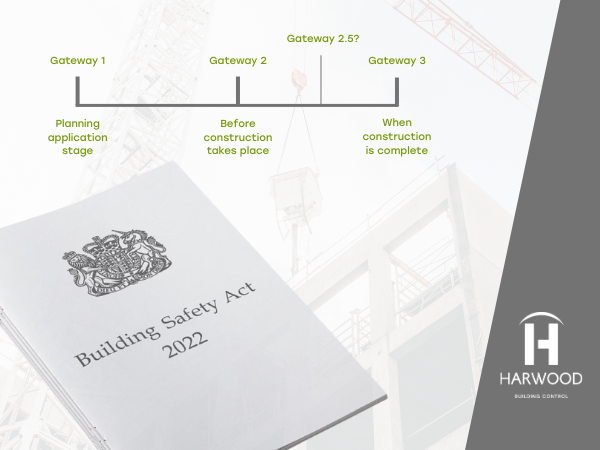We use cookies to provide you with a better experience and ads personalisation. Learn more in our Privacy Policy.
News
Dame Judith Hackitt raises concerns over cultural change and Gateway 2 delays
October 15, 2025

Dame Judith Hackitt, former Chair of the Health and Safety Executive and author of the post-Grenfell review of Building Regulations and Fire Safety, has warned that parts of the construction industry may be “going backwards” on cultural change since the Grenfell Tower tragedy. She also proposed a more flexible staged approval process for the Building Safety Regulator (BSR) — a “Gateway 2.5” — to ease delays while keeping safety as the priority.
In this blog, we explore why the industry is at this point, what Hackitt’s proposals mean in practice, and how Harwood Building Control is supporting developers, architects, and contractors to navigate the transition with confidence.
Why the industry is here
The Grenfell tragedy exposed deep flaws in building safety, leading to Hackitt’s 2018 Building a Safer Future review and the creation of the Building Safety Act and BSR. Transition has been difficult: Gateway 2 approvals, designed to take 8–12 weeks, now often stretch to 40–48 weeks, resulting in increased costs and delays.
In February 2025, the Government established the independent Building Control Independent Panel (BCIP), chaired by Hackitt, to review whether commercial interests should remain in building control. In June, the House of Lords Industry and Regulators Committee began a parallel inquiry into BSR performance. The following month, Hackitt gave evidence to the Lords Committee, and the BCIP published its Problem Statement, highlighting conflicts of interest, weak enforcement, and limited local authority capacity.
These systemic challenges directly affect the developers and designers we work with. By engaging early and preparing complete, robust submissions, many delays can be mitigated — but clearer guidance and consistency are essential.
Hackitt’s critique and proposed reforms
Hackitt acknowledged Gateway delays but argued many arise from incomplete applications, often linked to design-and-build contracts. To address this, she proposed a staged “Gateway 2.5” approval, which would allow certain design elements to be signed off earlier while maintaining key safety checks prior to occupation. She warned that pushing approvals to Gateway 3 would be “nonsensical” given the risks of late fixes. At the same time, she also emphasised the need for greater communication between industry and regulators, without fear of regulatory capture.
The BSR has accepted that staged approvals are under discussion and emphasised that poor-quality submissions remain a root cause of delays. Industry leaders have also welcomed “Gateway 2.5” but stress that this is not the only issue, and that there is still a need for more guidance, consistent regulation, and adequate resourcing to make it work in practice.
Harwood supports the principle of staged approvals to speed up delivery without compromising safety. However, success depends on regulators providing practical and consistent guidance, as well as ensuring that all requirements for design packs are met.
Building Control’s response to the Problem Statement
As a Registered Building Control Approver, Harwood sees the real-world impact of delays on projects. Ben Cheeseman, our Commercial Director, notes:
“Gateway 2 is vital to ensure buildings are safe by design, and we fully support it. The challenge is that delays often result from unclear guidance, conflicting regulations, and slow responses from the BSR.”
The Association of Building Control Approvers (ABCA) and its members have engaged with Dame Hackitt and the Independent Panel to discuss these challenges. While acknowledging the concerns raised, Building Control Approvers have emphasised the importance of:
• Better collaboration between public and private Building Control to reduce conflict.
• Clearer definition of Building Control’s role — enforcement, compliance, or risk management.
• A risk-based approach, focusing scrutiny on higher-risk projects rather than blanket application.
ABCA members also emphasised that clients – including major organisations such as the NHS, the MOD, and those in the nuclear sector – select their regulators based on service quality and reliability, rather than price or ease of approval. This challenges the assumption that private building control bodies compete mainly by being cheaper or more lenient.
Some developers are now producing higher-quality, more complete design packs, which are helping to reduce rejection rates.
Regulatory guidance and expert support will be vital
While Dame Hackitt acknowledged the regulator could offer clearer guidance, she stressed that responsibility for higher standards lies with those submitting applications. For designers and developers, this means producing more complete submissions and moving beyond a tick-box approach.
A cultural reset will depend on consistent guidance, robust applications, and early engagement across the supply chain. Harwood is committed to helping clients meet these challenges, managing risks effectively, and fostering collaboration between designers, developers, and regulators to reduce delays and deliver safer buildings.
For more information on how we can support your projects through the Gateway process, please contact our team. Call 01227 931 777 (Canterbury), 01908 012 6669 (Milton Keynes), 0114 321 8999 (Sheffield) or email enquiries@harwood.uk.com.